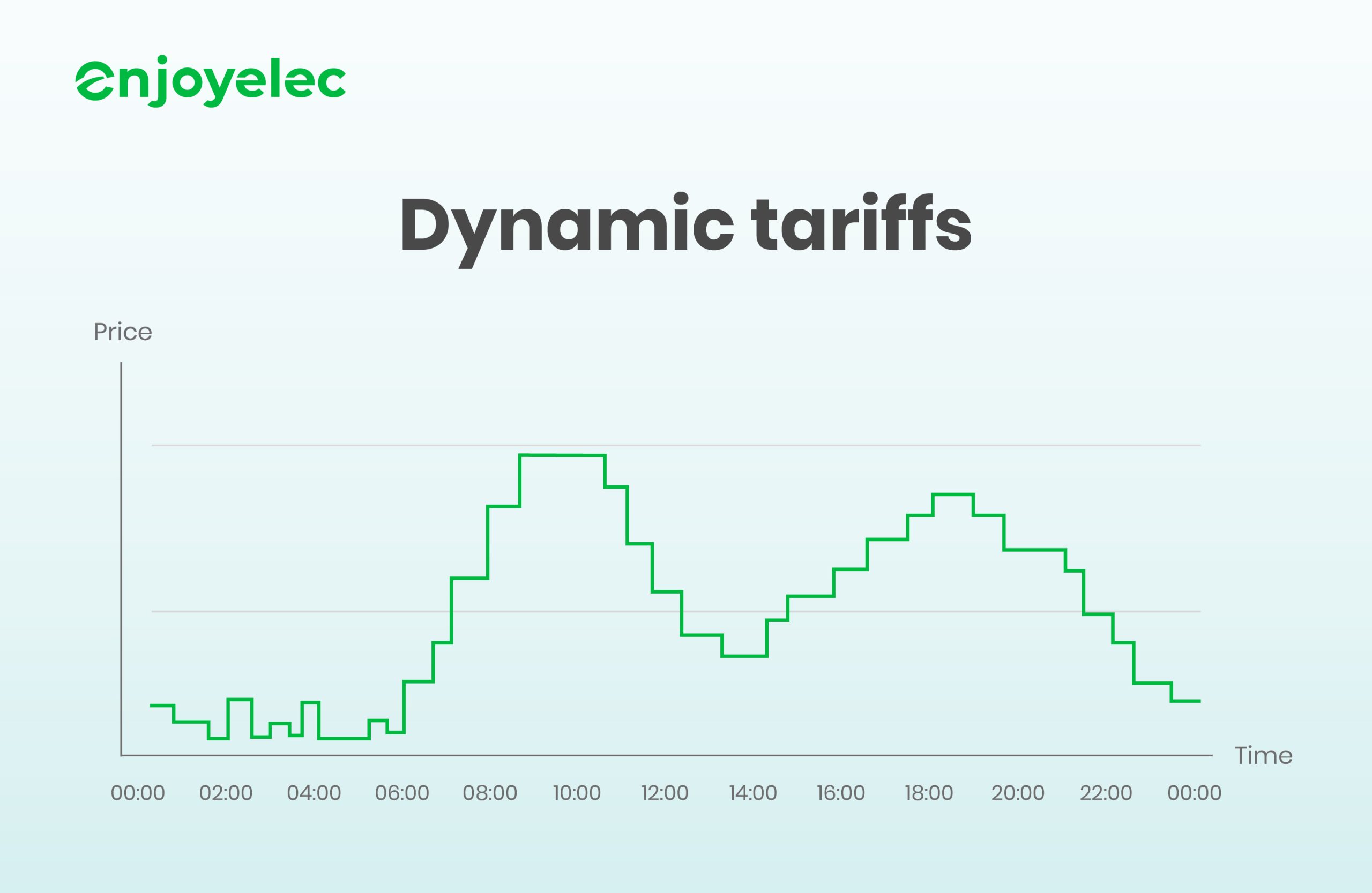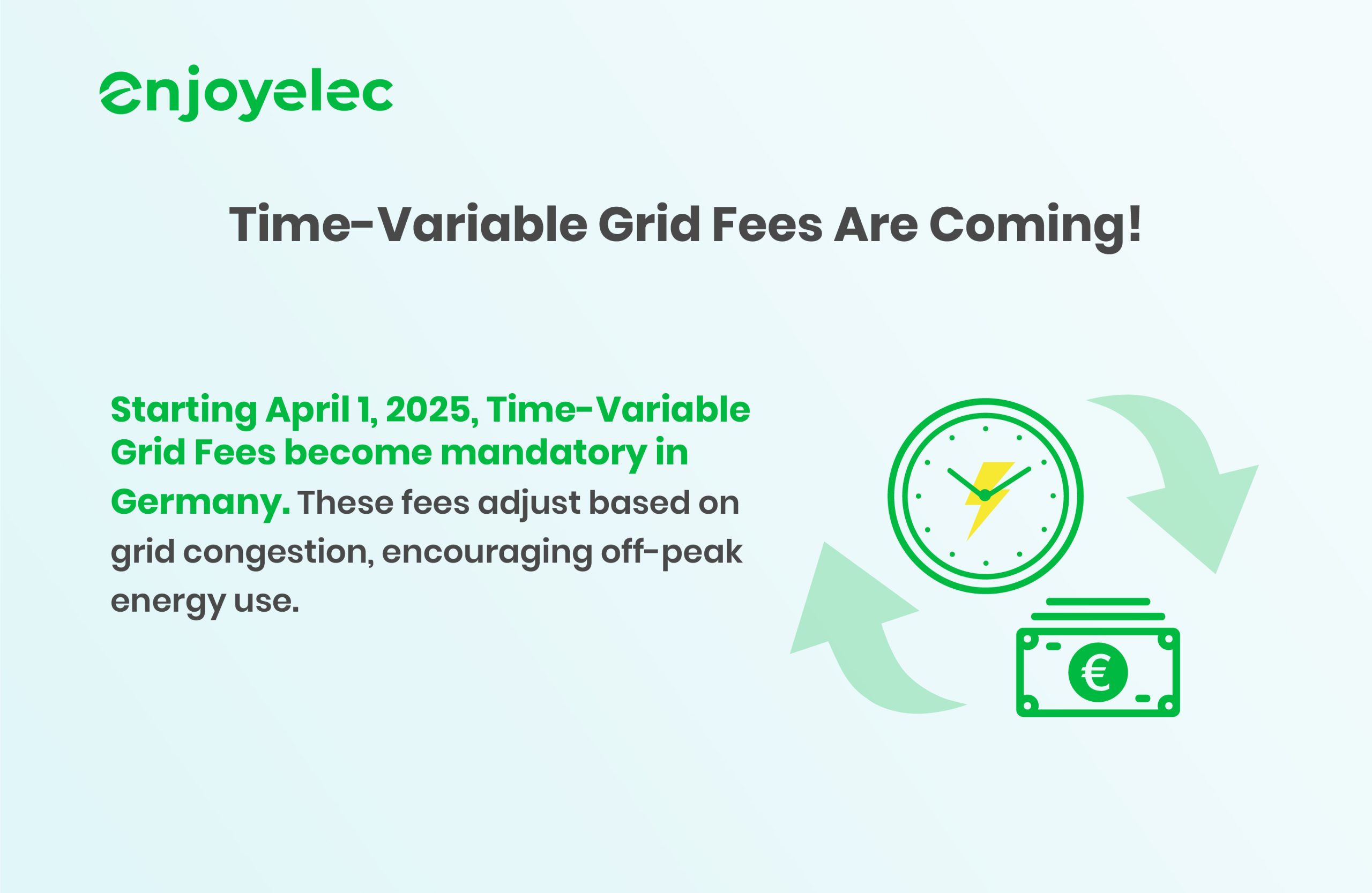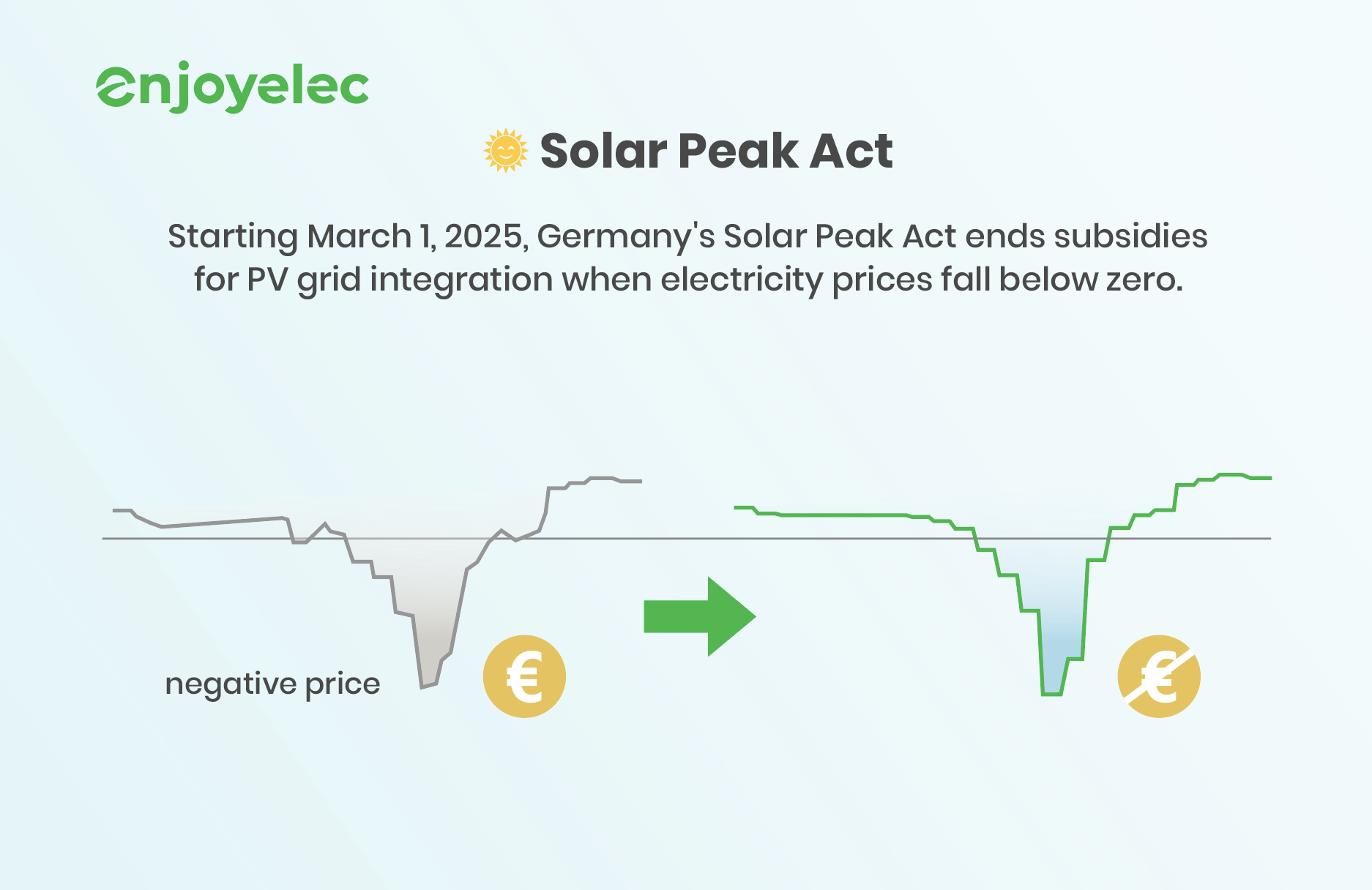Maximizing Grid Stability with Demand Response Strategies
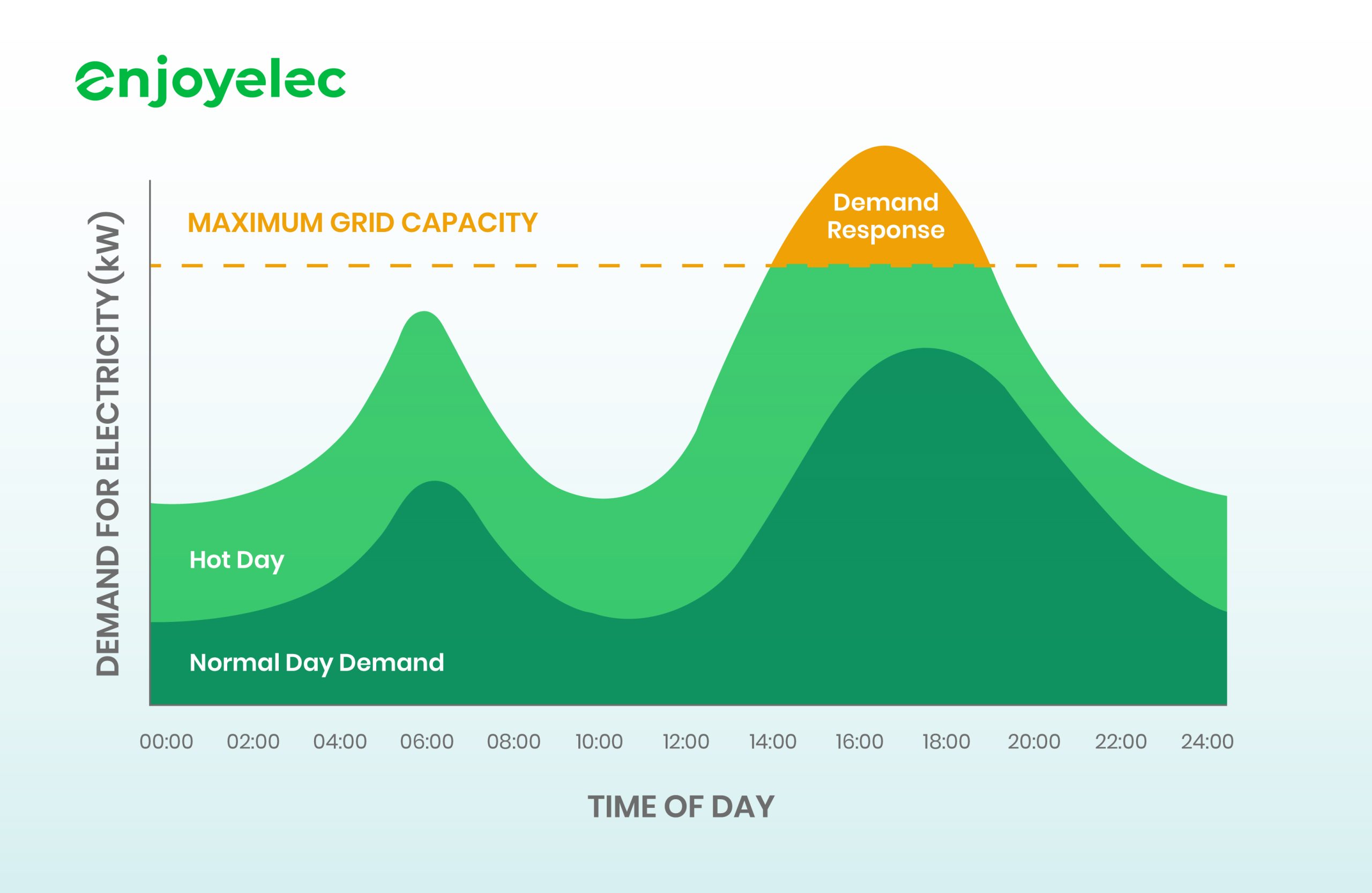
How does demand response work?
Demand response (DR) is a strategy that manages and adjusts the demand for electricity, especially during peak usage times or periods of high electricity prices. When electricity demand is high or there is a supply constraint, utility companies or grid operators send a signal to participating consumers, indicating the need to reduce or shift their electricity usage.
Consumers respond to this signal by reducing their electricity consumption or shifting their usage to off-peak times. This can be done manually by adjusting usage patterns or automatically through smart devices and systems. Many DR programs use automated systems to control appliances, heating, cooling, and industrial processes, which can be pre-programmed to respond to DR signals without user intervention.
To encourage participation, utilities often offer incentives such as lower rates, rebates, or direct payments to consumers who reduce their usage during DR events. By reducing or shifting electricity usage, demand response helps to flatten the peak demand curve, preventing the need for additional generation capacity and reducing the strain on the grid.
Demand response contributes to grid stability by balancing supply and demand in real-time and can lead to cost savings for both utilities and consumers by avoiding the high costs associated with peak power generation. For example, a smart thermostat in a home can automatically adjust the air conditioning when a DR event is triggered, reducing energy consumption during peak hours. In commercial or industrial settings, factories may temporarily reduce production processes or switch to backup generators during a DR event to decrease their load on the grid.
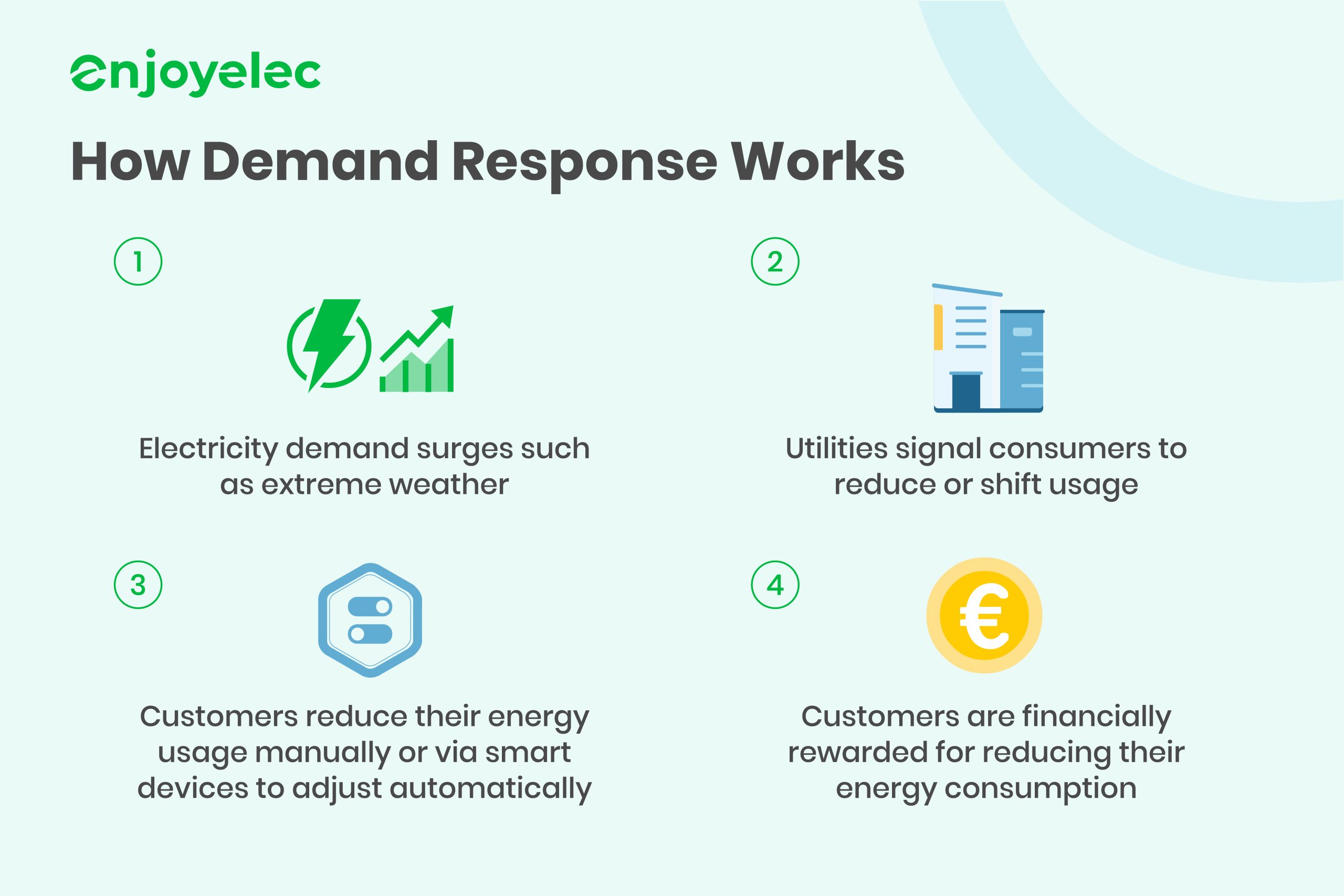
How can my household participate in demand response?
To effectively engage in Demand Response (DR) and contribute to grid stability, households can leverage various strategies and technologies. Here’s how you can get involved:
-
Time of Use Pricing (TOU): Many European regions implement TOU pricing, which sets different electricity rates for various times of the day. By shifting household energy use to lower-cost periods, such as running appliances like washing machines and dishwashers during off-peak times, you can participate in demand response and reduce your electricity bills.
-
Smart Home Systems:With enjoyelec HEMS app, you can connect with your solar system, home battery , EV charger, HVAC, enabling you to manage your energy consumption more efficiently and generate sufficient flexibility to support the grid as well as to shift the consumption behavior.
-
Solar System:By connecting with solar, you can generate your own renewable energy, reducing your reliance on the grid during peak demand times. This not only lowers your electricity costs but also supports grid stability by decreasing the overall load on the grid.
-
Battery Energy storage system:With a battery energy storage system, you can store excess energy produced by your solar panels or charge the battery during off-peak hours when electricity rates are lower. During peak periods, you can then discharge the stored energy to power your home, avoiding high electricity costs and contributing to demand response efforts.
-
EV charging: Smart EV charging allows you to schedule your vehicle’s charging during off-peak hours when electricity is cheaper and demand is low. Additionally, during demand response events, your EV’s battery can serve as an energy source, providing power back to your home or the grid, further reducing peak demand.
-
HVAC: Heating, Ventilation, and Air Conditioning (HVAC) systems can be optimized for demand response by adjusting temperature settings in response to signals from your utility. By slightly reducing heating or cooling during peak times, you can lower your energy usage without compromising comfort, helping to alleviate stress on the grid and reduce energy costs.
-
Demand Side Management (DSM) Programs: Some European regions offer DSM programs that encourage users to reduce their electricity use during peak periods and increase consumption during off-peak times. These programs might include mechanisms like Direct Load Control (DLC) and Interruptible Load, allowing utilities to remotely control certain appliances during emergencies. Participation usually requires signing an agreement with the utility and may come with compensation or incentives.
-
Community-Level Demand Response: In some European communities, residents are organizing collective demand response efforts. By coordinating energy use at the community level, these initiatives manage overall load more effectively, lower collective energy costs, and reduce strain on the grid. Successful participation requires active involvement and cooperation among community members.
Demand Response VS Demand-Side Flexibility
Demand Response (DR) represents a vital mechanism in modern power systems, where electricity users adjust their consumption patterns in response to changes in market prices or incentives offered by utilities. When faced with periods of peak demand or potential grid instability, DR programs encourage or incentivize customers to temporarily reduce their electricity usage. This short-term behavioral change helps balance supply and demand, maintains grid reliability, and can even moderate electricity prices. DR is a proactive approach that leverages the collective flexibility of the demand side to support the efficient operation of the power grid.
On the other hand, Demand-Side Flexibility (DSF) encapsulates a broader concept that emphasizes the ability of electricity users to adapt their consumption patterns in a flexible manner. DSF transcends the traditional realm of DR by recognizing that users can not only respond to external signals but also proactively manage their energy use based on personal preferences, market dynamics, and technological advancements. It encompasses a wide range of strategies and technologies, such as smart meters, energy efficiency programs, demand-side management systems, and distributed energy resources. DSF fosters a more dynamic and interactive relationship between electricity users and the grid, enabling them to contribute actively to its stability and resilience.
The distinction between DR and DSF lies in their scope and emphasis. DR focuses on specific, targeted responses to immediate grid needs, while DSF encompasses a more holistic view of the demand side’s potential to contribute to grid flexibility over a broader range of timeframes and operating conditions. However, the two concepts are complementary, as DSF provides the foundation for the successful implementation of DR programs. As the power sector evolves towards greater decentralization, digitization, and decarbonization, the importance of leveraging DSF and DR becomes increasingly evident in ensuring a reliable, sustainable, and cost-effective energy future.
With the integration of renewable energy sources and the rise of distributed generation, the need for demand-side flexibility becomes even more critical. By empowering users to actively participate in managing their energy consumption, DSF and DR contribute to a more resilient and adaptable power system that can better withstand fluctuations in supply and demand. In turn, this fosters a more inclusive and collaborative energy ecosystem, where all stakeholders play a role in shaping a sustainable energy future.
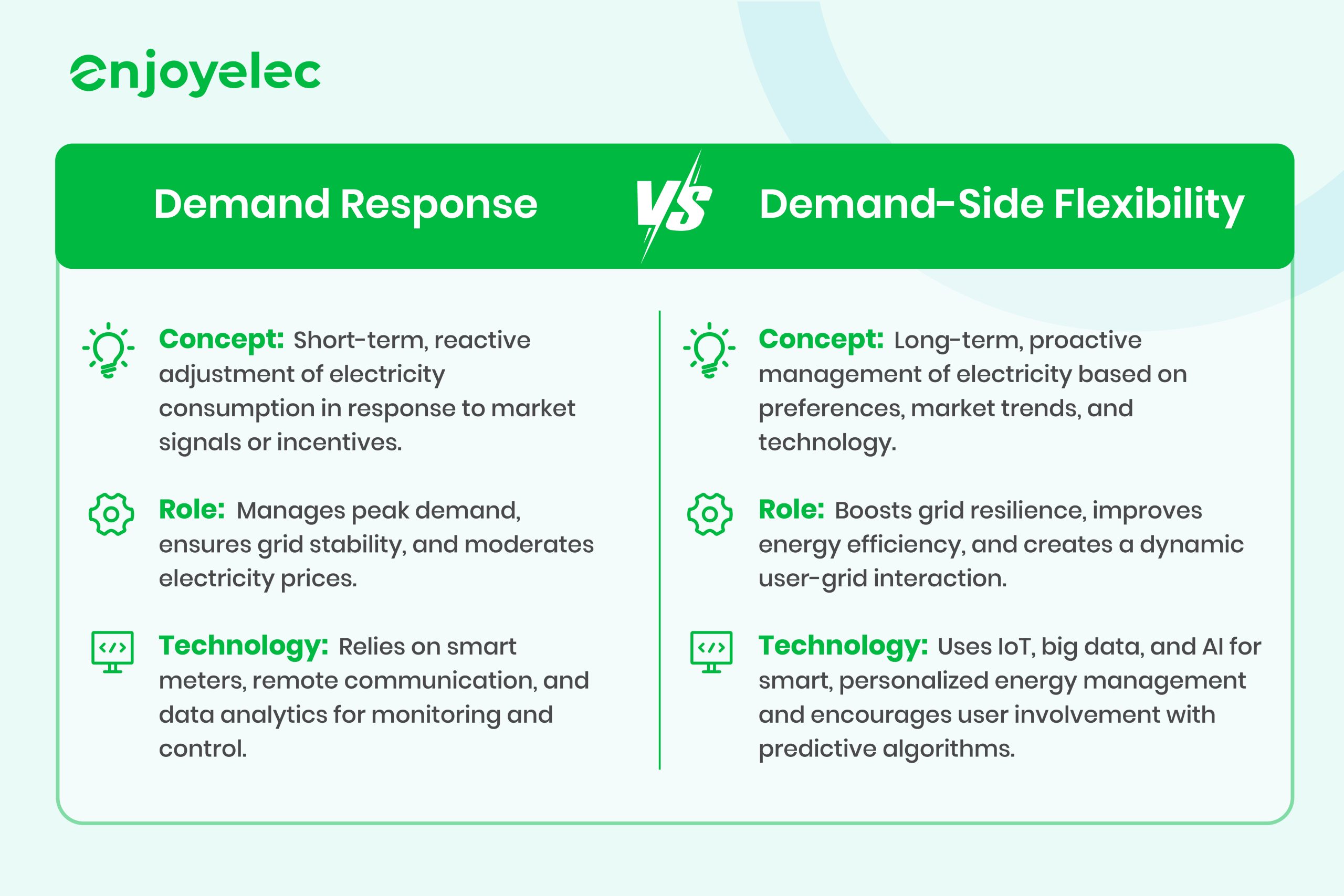
Demand Response VS Peak Shaving
Demand Response (DR) and peak shaving might seem interchangeable due to their shared objective of curtailing electricity consumption during peak hours. However, delving deeper, one discovers their uniqueness rooted in scale, methodology, and ultimate purposes.
Firstly, DR emerges as a broader strategy embraced by utilities and grid managers, operating on a grand scale. Conversely, peak shaving is a more localized endeavor, typically practiced by individual enterprises or households, impacting only the power consumption within a designated building or installation.
Secondly, the tactics employed by these two approaches differ significantly. DR programs leverage pricing mechanisms or financial incentives as catalysts to incentivize reduced consumption. On the other hand, peak shaving often incorporates the deployment of onsite energy management systems, which can function autonomously, eliminating the need for behavioral changes on the part of the consumer.
Lastly, their underlying objectives diverge. DR aims to uphold grid stability and bolster efficiency on a systemic level, while peak shaving is fundamentally geared towards trimming energy bills for individual entities, thereby promoting cost-effectiveness at the local level.
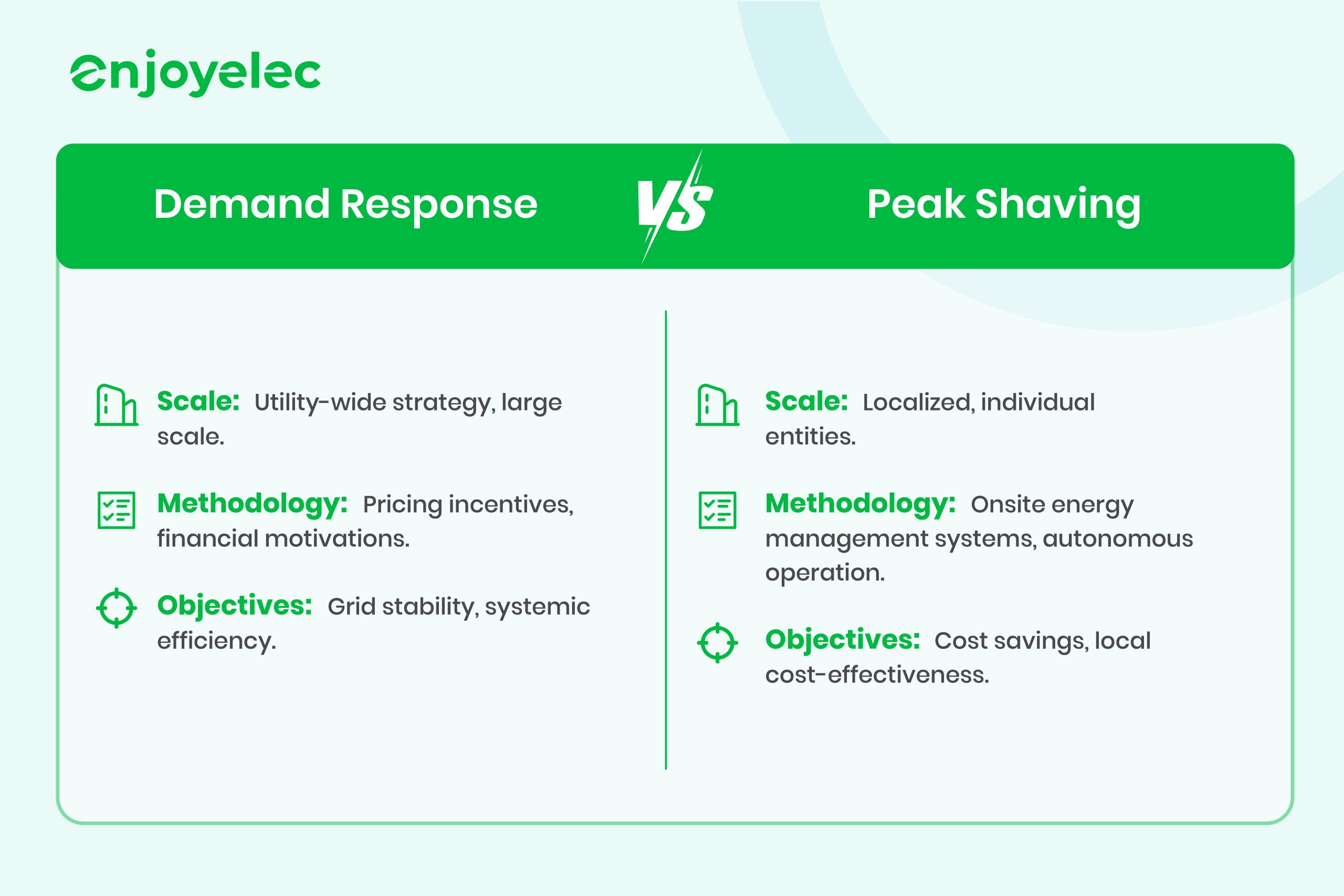
Benefits of Demand Response
Demand response is an innovative energy management strategy that offers numerous benefits for both consumers and the power grid.
-
Cost Savings for Utilities and Consumers: By optimizing the use of existing generation assets and reducing the need for costly peak-time generation, DR programs can lead to substantial cost savings for utilities. These savings can be passed on to consumers through lower electricity rates or through direct incentives for participation in DR programs.
-
Environmental Benefits: Reduced reliance on fossil fuel-based power generation during peak hours can lead to significant decreases in greenhouse gas emissions and other pollutants, contributing to a cleaner and more sustainable environment.
-
Grid Stability and Reliability: When the grid faces unexpected high demand or supply disruptions, DR programs can quickly respond by reducing demand, thereby alleviating stress on the system and minimizing the risk of blackouts or brownouts. This enhances grid stability and reliability.
-
Energy Efficiency: By incentivizing customers to reduce their energy consumption during peak demand periods, DR programs help flatten the overall demand curve, resulting in more efficient use of generation resources. This leads to less wasted energy and lower overall energy costs.
-
Enhanced Integration of Renewable Energy Sources: As renewable energy sources like solar and wind become more prevalent, their intermittency poses challenges for grid management. DR programs can help balance out supply fluctuations by adjusting demand in real-time, facilitating the integration of renewables into the grid.
Challenges and Barriers to Demand Response Adoption
- Absence of an adequate legal framework for market access
The rules and laws around demand response (DR) haven’t fully caught up with the technology in some regions of Europe. For example, some countries haven’t clearly defined the roles and responsibilities of new players in the energy market, like those who aggregate small-scale energy resources. This means that not everyone can participate in the electricity markets or provide grid services, which limits the potential of demand response. For demand response to reach its full potential, it’s crucial that governments establish clear and inclusive legal frameworks. This would allow all types of energy resources to participate in the market, promote fair competition, and encourage the adoption of new technologies.
-
Insufficient incentives to encourage flexibility
ACER reports that in almost half of the EU Member States, consumers are unable to take advantage of demand response because they lack access to smart meters, which provide real-time data and price signals. Without these devices, it’s difficult for consumers to adjust their energy usage during times when it would most benefit the energy system. Some countries, like Austria, Slovakia, Romania, Poland, and Cyprus, have set legal targets to roll out smart meters to 80% of households but are still far from achieving these goals. Others, such as Hungary, Lithuania, and Greece, have not yet committed to reaching this target, even though they have started the rollout process. In some cases, the rollout rate is below 20%, making it challenging for these countries to effectively implement demand response initiatives.
-
Interventions in retail pricing
At least thirteen EU Member States had regulated price systems in place, often with fixed prices, even before the energy crisis. These controls were generally not limited to vulnerable consumers, meaning many households and businesses were insulated from price signals that could encourage demand response. During the energy crisis, temporary measures were introduced to curb retail price increases, but these may have further reduced incentives for demand response, as noted in ACER’s 2023 Market Monitoring Report.
- Limited Competition in Retail Electricity Markets
The ability for new entrants to successfully join the electricity market largely depends on the presence of strong and effective competition within the retail market.Competition in some retail energy markets can still be enhanced to better support the entry of new players who can tap into the flexibility of distributed energy resources. Many Member States exhibit high levels of market concentration, which is not always due to their small size. The dynamics of market entry and exit differ significantly across the EU, with less active markets observed in countries like Malta, Sweden, France, Greece, Portugal, Ireland, the Netherlands, Poland, and Romania.
The future of Demand Response
The future of Demand Response (DR) is set to play a transformative role in the global energy transition, driving the shift towards a more sustainable and resilient energy system. As the world increasingly moves towards decarbonization and the integration of renewable energy sources, the need for flexible and responsive energy management becomes more critical. Demand response is uniquely positioned to address these needs by enabling real-time adjustments in electricity consumption based on grid conditions, thereby optimizing the balance between supply and demand.
The International Energy Agency (IEA) has underscored the urgency of accelerating both policy implementation and technology deployment for demand response. In their Technology Deep Dive, the IEA highlights that achieving the Net Zero Scenario will require a significant scaling of demand response capabilities, with a target of 500 GW of capacity by 2030. This represents a tenfold increase from the levels observed in 2020, illustrating the magnitude of the challenge and the opportunity ahead.
Demand response is essential for balancing electricity supply and demand, especially as renewable energy sources become more prominent. By reducing the strain on the grid, particularly during peak demand periods, demand response helps mitigate the impact of large-scale energy consumers and supports the integration of renewable energy into the grid. This not only enhances grid stability but also fosters a more resilient and sustainable energy system.
Looking ahead, the successful expansion of demand response will depend on continued innovation, supportive regulatory frameworks, and widespread adoption. As demand response becomes more embedded in the energy landscape, it will not only contribute to grid reliability but also play a crucial role in achieving global climate targets and ensuring a sustainable energy future for all.
Download the HEMS app now to learn more.


Connect with us at http://www.linkedin.com/company/enjoyelec for the latest updates, insights, and news. We look forward to engaging with you and sharing our journey towards a smarter energy future.



